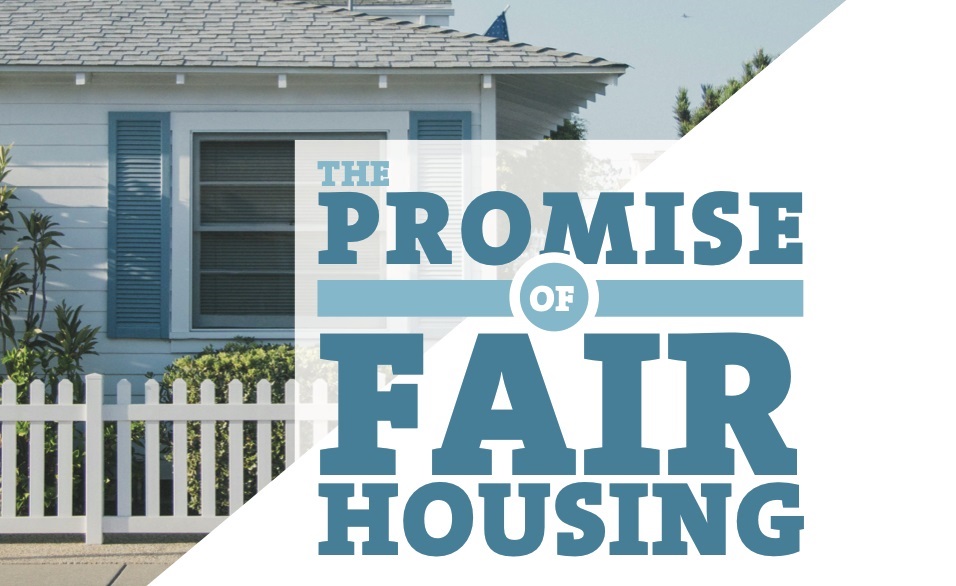The Promise of Fair Housing
A Place to Call Home Is a Fundamental Civil Right

When people feel welcomed in their neighborhood, they invest in their community and make it an appealing place for diverse and talented people to live. Housing discrimination is not only illegal, but it contradicts the principles of freedom and opportunity that Americans treasure. Equal access to rental housing and home-ownership opportunities is a cornerstone of federal housing policy.
Many people are aware of the shameful history of housing discrimination in the United States. It was common practice for African Americans to be denied the opportunity to purchase homes or to be subject to “redlining,” a discriminatory practice involving lenders that refused to lend money or extend credit to borrowers in certain areas of town or Realtors who would not show properties to certain types of people in certain neighborhoods.
The impact of lawful discrimination and redlining is still felt today. A 2018 study by the National Community Reinvestment Coalition shows that the majority of neighborhoods marked “hazardous” in redlined maps drawn by the federal Home Owners’ Loan Corporation from 1935 to 1939 are today much more likely than other areas to include lower-income, minority residents.
This month is Fair Housing Month, a time that the U.S. Department of Housing and Urban Development (HUD) recognizes as a time to celebrate the Fair Housing Act and to encourage us to recommit to ensuring that all members of our community have equal opportunity to access housing.
The federal Fair Housing Act makes it unlawful to discriminate in housing transactions based on race, color, national origin, religion, sex, disability, or family status. In California, two additional laws also make it unlawful to discriminate in housing based on gender, gender identity, sexual orientation, marital status, immigration status, and source of income.
These laws govern all aspects of housing transactions, including renting or leasing, sales, mortgage lending, restrictive covenants, advertising, and more.
What does the promise of fair housing mean today? Discrimination is often subtler and less overt than in years past, but its impact is still felt, and consequences may be severe. It could mean that a gay couple is asked more questions upon applying for rental housing than a straight couple, which deters the couple from submitting an application. A woman living in subsidized housing might be subject to unwanted sexual harassment from a property manager but be afraid to report the problem for fear of losing her housing. A person with a mental disability may be denied a reasonable accommodation by a landlord.
Discrimination also plays out in online advertising for rentals. Coded language may have a discriminatory impact on who chooses to apply. Social media algorithms may target housing advertisements to people of certain genders, races, or marital statuses in an unlawful manner.
The best practice for all owners, Realtors, advertisers, and property managers is to treat each applicant equally and to follow the same procedures for all potential housing applicants. By following a set of objective procedures, people reduce the risk that implicit bias will impact decision making.
At the Legal Aid Foundation of Santa Barbara County, we advise and represent tenants who believe they may be impacted by unlawful discrimination. We also conduct community legal presentations on fair housing to help prevent discrimination before it happens. We receive funding from the County of Santa Barbara, the City of Santa Maria, and the City of Lompoc to ensure that our communities are aware of fair-housing responsibilities and protections.
The promise of fair housing is important to remember in a time of housing shortage. We sometimes hear talk about the high cost of living in Santa Barbara County and how only certain people should have the opportunity to live here. We hear the fears about immigrant farmworkers living in H-2A housing or concerns about allowing multifamily apartment complexes in certain neighborhoods. Implicit and sometimes explicit bias may underlie these concerns and fears.
Our dedicated attorneys and staff at the Legal Aid Foundation of Santa Barbara County are working to raise awareness in our community about fair housing laws and to ensure that the promise of fair housing is protected for all Santa Barbara County residents. We hope you will join us in making sure that this promise continues in the years and decades to come.
For more information about Fair Housing rights and responsibilities, visit our website at lafsbc.org/fair-housing.
Jennifer Smith is an attorney and executive director of Legal Aid Foundation of Santa Barbara County. Tanya Villegas is the managing attorney of the Santa Maria office. Chandra Carr is a staff attorney in Santa Barbara.



